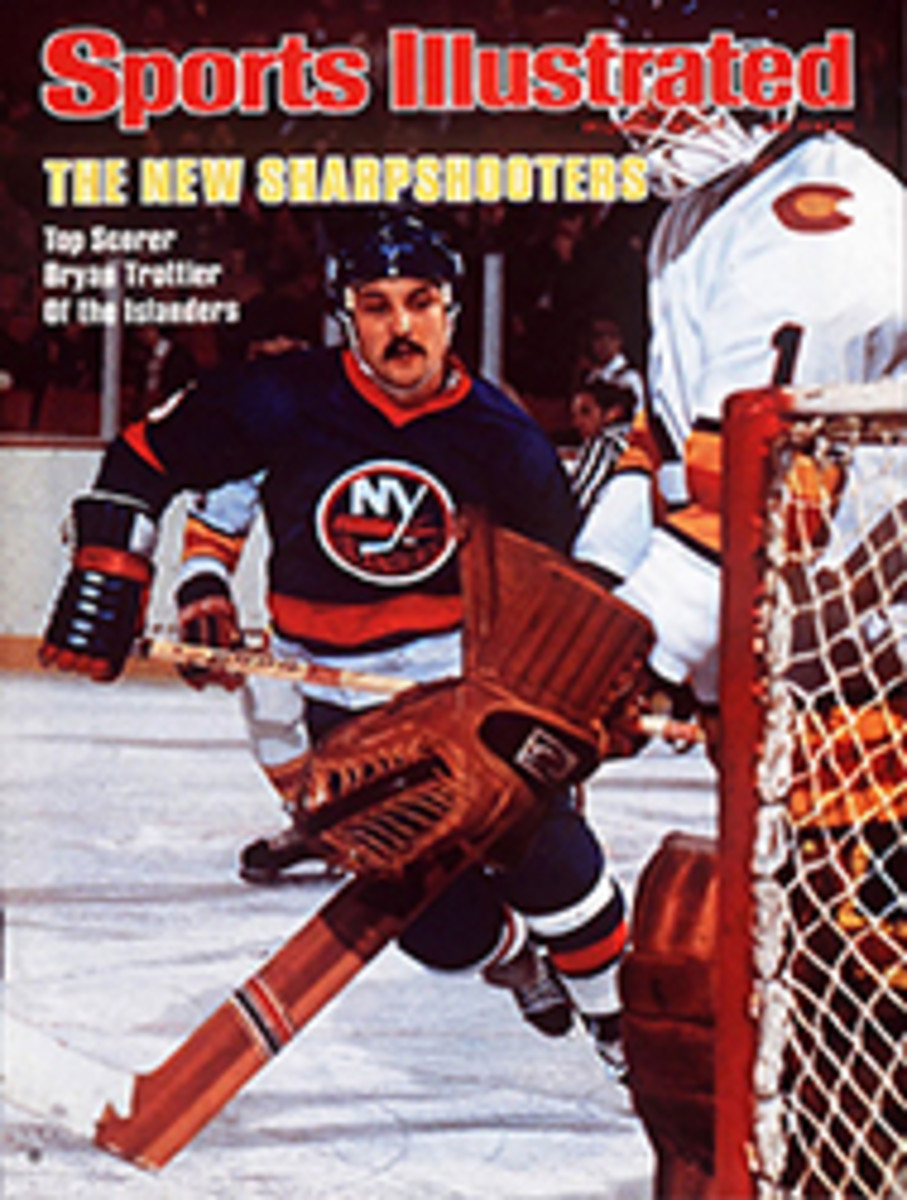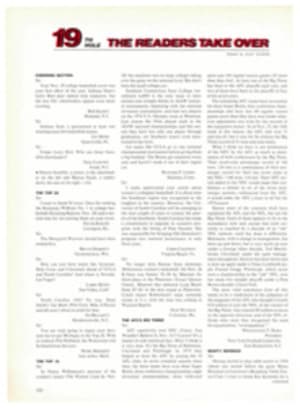
SCORECARD
FLUBBED
The Pittsburgh Penguins of the National Hockey League, who made a couple of bad trades earlier this season, made a real bummer last week with the Montreal Canadiens. The dismal Penguins sent Pierre Larouche, an outstanding 22-year-old center who scored 53 goals two years ago, and "future considerations" to the powerful Canadiens for Peter Mahovlich, a 31-year-old center whose best games are behind him, and Peter Lee, a mediocre minor league winger.
The Penguins tried to explain the deal by saying that Mahovlich, who played on four Stanley Cup winners in Montreal, brings a winning attitude to a team that has never won anything.
Alas for Pittsburgh fans, and alas for the NHL, John A. Ziegler, the new league president, failed to take action on the trade, which makes already heavily favored Montreal practically overwhelming. Ziegler could have done what Bowie Kuhn did two years ago when the baseball commissioner stopped Charlie Finley's fire sale of the Oakland A's, but Ziegler flubbed his first major chance to improve the league competitively. His silence promises more trouble for a sport up to its helmets in difficulties.
HOT WHEELS
The dog ads in The New York Times recently carried the following under the heading AT STUD: PORSCHE, '73 911T, MAGS., STEREO, PIRELLI TIRES, KONI SHOCKS 212-674-8291 ANYTIME.
FIGURING SKY KING
Slugger Dave Kingman has hit some shots playing against the Cubs in Wrigley Field. Two summers ago while with the Mets, Sky King hit a ball that soared over the fence in left center and across Waveland Avenue and finally struck the porch of the third house up the block on Kenmore Street, 600 feet away. Now that the Cubs have signed Kingman to a five-year contract for $1.2 million, there is talk that he will break Roger Maris' asterisk record of 61, what with the left-field fence only 365 feet away up the power alley.
Faint hope, says Robert H. Kingsley of the Kingsley Baseball Service in Rockville, Md., a specialist in home runs. According to Kingsley, whose mathematical calculations take into account such factors as Kingman's career home runs per at bats (15) and the distances at Wrigley Field, Sky King will fall far short of the record. "He's going to hit three or four memorable homers for distance," says Kingsley, "and fans are going to talk about them. But my figures show that the fences don't do him as much good as they do shorter home-run hitters." O.K., so how many homers is Kingman going to hit next season? "Fifty is the most probable number," says Kingsley, "and the guy has to play every day to do that."
VEGETABLE POWER
According to an old saying, there is no one with endurance like the man who sells insurance, and a couple of Florida insurance men are well on the way to proving it. John N. Peele, 28, and Brian E. Hassell, 27, are running across the United States to promote the benefits of vegetarianism. They left their hometown of Orlando on Oct. 1, World Vegetarianism Day, and last week, after averaging 45 to 50 miles a day, with Sundays off to forage for food, they passed through Lubbock, Texas, the midway point. They expect to reach Los Angeles on New Year's Day.
So far they have been given the keys to several cities, even in the heart of Texas cattle country, where Peele announced, "People are literally addicted to the poisons found in meat." Peele and Hassell begin each day at eight by downing three tablets apiece of bee pollen and then do 350 push-ups, 50 to 100 sit-ups and up to half an hour of stretching exercises for the legs and lower back. Before starting on the road, they have one or two cups of ginseng tea and vitamin C and E supplements. After running half the day's distance by noon, they lunch on fruit or carrot juice and alfalfa and/or wheat sprouts. The sprouts are grown en route in trays inside a camper driven by Peele's wife, Nancy.
After finishing the day's run at six, they chow down with a salad of sprouts, raw spinach, carrots and cauliflower. They already consider their run a success for vegetarianism. Most people, says Hassell, expect vegetarians to be "pale and sickly. I think we've proved them wrong."
THE HOLE IDEA
A couple of weeks ago we told you about John Bennett of East Peoria, Ill., who invented a baseball bat with a 19-degree bend in the handle. Now we present another inventor who has gone batty, Joe Martino of Brooklyn, who has patented the Prac-Bat, which has a big hole in it.
The hole, seven by 3½ inches, is in the meat or "sweet" part of the bat. A batter who swings at the ball and misses as it goes through the hole knows that his swing is on target and that had he been using a regular bat he would have made solid contact with the ball.
A good-field, no-hit ballplayer in the Army, Martino dreamed of being a .400 hitter and making the majors. He never did get near .400, or the majors, but he did dream up the Prac-Bat six years ago as a tool to improved hitting. Neighborhood kids have gone wild over it. The Prac-Bat corrects the hitter who tends to roll or twist his wrists too soon, because then the ball can't enter the hole. Similarly, the Prac-Bat corrects a tendency either to uppercut or to chop down at the ball.
Martino is now trying to find a manufacturer in this country who will mass-produce a lightweight, high-density plastic Prac-Bat that either kids or adults can use with a tennis ball. A major Japanese sporting-goods firm is looking over the bat now, but Martino says, "It's a shame if I'm forced to go to a company in the Orient."
EXIT TROGNITZ
Tough guy Willie Trognitz, signed for a 10-game trial by the Cincinnati Stingers of the WHA after he was banned for life by the International League for messing up an opponent with his stick (SI, Nov. 28), has been dropped. Trognitz dressed for the 10 games, played in seven and picked up 37 minutes in penalties, 25 in one outing against Quebec, but he did not play up to expectations.
The Stingers did offer Trognitz another 10-game trial at $150 per game, but he refused. "What's $150?" he asked. "I got guys making $150,000 hiding behind my back."
BABES IN THE WOODS
While most people are engaged in raking leaves, or swearing at them, certain ecologists are busy studying them. Singular though this might seem, it makes sense: in recent years there has been increasing recognition of the critical importance of dead leaves; in fact, the number and size of fishes in many waters may well depend on the leaf fall.
For the last three winters, Dr. Robert Goodland of the New York Botanical Garden has been doing "nutrient profiles" on leaves from 71 species of trees and shrubs on the grounds of the Carey Arboretum in Millbrook, N.Y. He has found that leaves from white ash and flowering dogwood are rich in calcium, and those from the American and slippery elms high in potassium. He has also discovered that hickory and butternut leaves accumulate extraordinarily high amounts of aluminum, a metal toxic to most other trees.
A forest drops about 3,000 pounds of leaves per acre, and on the ground they are consumed by bacteria, fungi, earthworms and insects. Another ecologist, Dr. Dominick J. Pirone of Manhattan College, is particularly interested in what goes on inside a leaf. "It's a whole world of its own for leaf miners," says Pirone, "mainly the larvae of microlepidoptera, tiny moths with a wingspan down to less than a tenth of an inch, that are among the most beautiful creatures on earth." (In Mexico, the caterpillar of the micro-moth Carpocapsa saltitans lives in the seedpods of milkweed. If the pod on the ground is in a bad position, where, say, there is too much sunlight, the caterpillar flexes its muscles to make the pod shift to a more favorable site. Thus the "Mexican jumping bean.")
In lakes and streams, dead leaves serve as a basic source of food for aquatic organisms. Some larvae of caddis flies, an important food for trout, not only eat leaves, but also use them to construct houses in which they live underwater. Many stone flies, another important food for trout, prefer to eat leaves that drop in the stream rather than submerged plants. Indeed, different species of stone flies have marked preferences.
"Nature exists by recycling every molecule," Pirone says. "When most people think of science, they think of spaceships. Instead, they should think about the leaves on the trees and on the ground. We're just babes in the woods when it comes to understanding the essential details of basic ecological processes."
PUN MY NAME
Richard Lederer, an English master at St. Paul's School in Concord, N.H., has spent the past year researching writers of literature and the sports their names suggest. The list reaches from antiquity to the present. For example, bowling includes Pindar, Edwin Markham, Mickey Spillane and Malcolm X. Ready for more? O.K.
Tennis: Miguel Cervantes, Richard Lovelace, Alfred, Lord Tennyson, Robert W. Service, Ivy Compton Burnett, Tennessee Williams and Kurt Vonnegut.
Track: Jonathan Swift, John Bunyan, John Crowe Ransom and Howard Fast.
Horse racing: Walter de la Mare, Stephen Vincent Benet, MacKinlay Kantor and Joyce Carol Oates.
Football: Joyce Cary, John Dos Passos and Robert Bloch.
Riflery: The Venerable Bede, Jean Cocteau, John Gunther, Nevil Shute, Robert Bolt and Kingsley Amis.
Groggy? There's more to come!
Skiing: C. P. Snow and Robert Frost.
Golf: Sara Teasdale and Graham Greene.
Crew: George Crabbe, Percy Shelley, Henry David Thoreau, George Orwell, Marianne Moore, Harper Lee and Iris Murdoch.
Basketball: Francis Scott Key, Henry Wadsworth Longfellow and John Fowles.
Rodeo: Thomas Bullfinch, Noel Coward, Albert Camus and Pearl Buck.
And finally,
Baseball: Plato, Henry Fielding, Richard Steele, Honoré de Balzac and the dean of them all, Homer.
MAD ABOUT FOOTBALL
Houston and Denver are two of the hottest football towns in the country. Take Houston and its TV shows. Besides the live NCAA and NFL games and the NCAA highlights, the football entertainment each week has ranged from hour-long programs featuring coaches Lou Holtz of Arkansas, Dan Devine of Notre Dame and Barry Switzer of Oklahoma to half-hour shows presenting coaches Grant Teaff of Baylor, Bill Yeoman of Houston, Homer Rice of Rice, Ron Meyer of SMU, Fred Akers of Texas, Emory Bellard of Texas A&M, F. A. Dry of TCU, Steve Sloan of Texas Tech and Tom Landry of the Dallas Cowboys. The hometown Oilers don't have a show, presumably because the market is already oversaturated.
Take Denver, where Judge John Sanchez last week ordered the Regional Transportation District to pay Mrs. Helen Harris $44.70, the cost of two tickets to the Bronco opener and two season passes on RTT buses, after a bus failed to pick her up for the game. "There is a great deal of difference in seeing the game on television and seeing it in person," Judge Sanchez said.
How right he is. With full-house crowds of 75,000 at Mile High Stadium, a lot of fans have taken to following the game on the tube in local bars. At the Arabian bar, those watching the Broncos play the Colts became irked by a blaring jukebox. They turned it off. Words followed. Finally, six people went outside, and when the shooting stopped one was dead and two wounded. The bartender told police all those involved were regular customers.
ILLUSTRATION
THEY SAID IT
•Dewey Selmon, inside linebacker of the Tampa Bay Bucs, losers of 26 consecutive regular-season NFL games, about his recent marriage: "I was going to wait and get married after we won our first game. But we decided against that."

